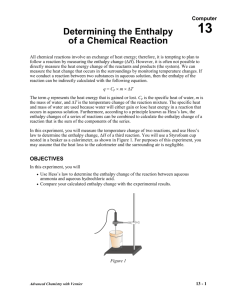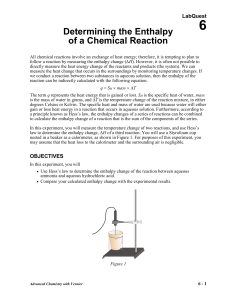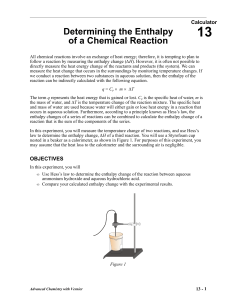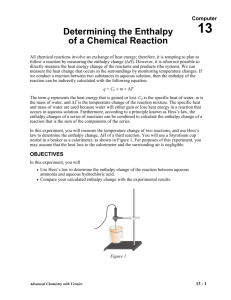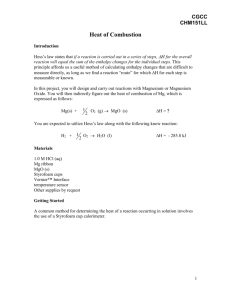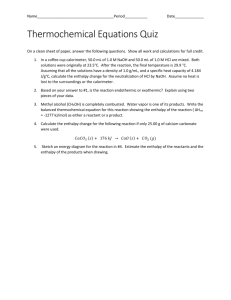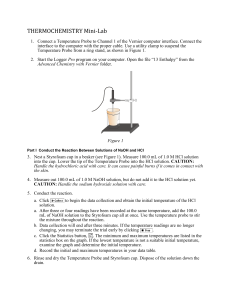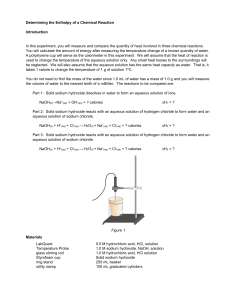Determining the Enthalpy of a Chemical Reaction
advertisement
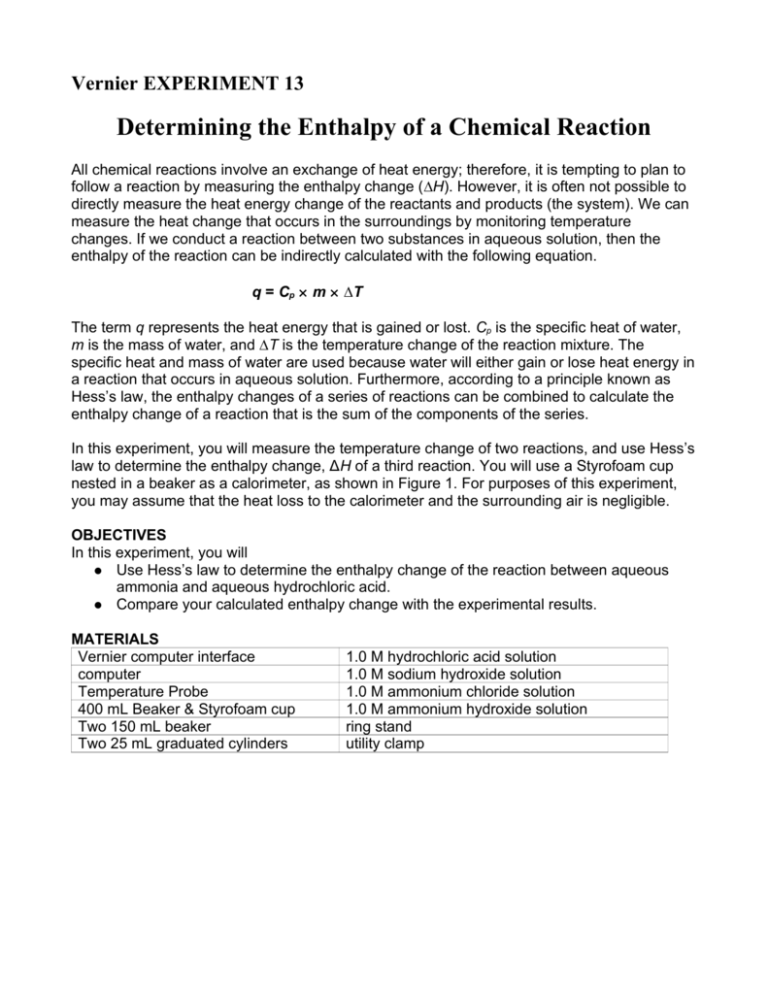
Vernier EXPERIMENT 13 Determining the Enthalpy of a Chemical Reaction All chemical reactions involve an exchange of heat energy; therefore, it is tempting to plan to follow a reaction by measuring the enthalpy change (∆H). However, it is often not possible to directly measure the heat energy change of the reactants and products (the system). We can measure the heat change that occurs in the surroundings by monitoring temperature changes. If we conduct a reaction between two substances in aqueous solution, then the enthalpy of the reaction can be indirectly calculated with the following equation. q = Cp × m × ∆T The term q represents the heat energy that is gained or lost. Cp is the specific heat of water, m is the mass of water, and ∆T is the temperature change of the reaction mixture. The specific heat and mass of water are used because water will either gain or lose heat energy in a reaction that occurs in aqueous solution. Furthermore, according to a principle known as Hess’s law, the enthalpy changes of a series of reactions can be combined to calculate the enthalpy change of a reaction that is the sum of the components of the series. In this experiment, you will measure the temperature change of two reactions, and use Hess’s law to determine the enthalpy change, ΔH of a third reaction. You will use a Styrofoam cup nested in a beaker as a calorimeter, as shown in Figure 1. For purposes of this experiment, you may assume that the heat loss to the calorimeter and the surrounding air is negligible. OBJECTIVES In this experiment, you will Use Hess’s law to determine the enthalpy change of the reaction between aqueous ammonia and aqueous hydrochloric acid. Compare your calculated enthalpy change with the experimental results. MATERIALS Vernier computer interface computer Temperature Probe 400 mL Beaker & Styrofoam cup Two 150 mL beaker Two 25 mL graduated cylinders 1.0 M hydrochloric acid solution 1.0 M sodium hydroxide solution 1.0 M ammonium chloride solution 1.0 M ammonium hydroxide solution ring stand utility clamp Figure 1 REACTIONS The table of thermodynamic data in your text is incomplete so the heats of formation are provided here. Reaction 1: An aqueous solution of sodium hydroxide reacts with an aqueous solution of hydrochloric acid, yielding water and an aqueous solution of sodium chloride. Reaction 2: An aqueous solution of sodium hydroxide reacts with an aqueous solution of ammonium chloride, yielding aqueous ammonia, NH 3, an aqueous solution of sodium chloride and water. Reaction 3: An aqueous solution of hydrochloric acid reacts with aqueous ammonia, NH 3, yielding aqueous ammonium chloride. Heats of Formation (∆ Hf * kJ) / mol H+ 0 _ -230 H2O -285.8 NH3 -80.3 NH4+ -132.5 OH Reaction Balanced net ionic equation 1 OH- + H+ → H20 2 3 - -285.8 - (-230 + 0) + OH + NH4 → H20 + NH3 + H + NH3 → NH4 ( products – reactants ( ∆ Hf * kJ) / mol ) + ∆ H (kJ/mol) -55.8 -285.8 + (-80.3) - (-230 + (-132.5) ) -3.6 -132.5 - ( 0 + (-80.3) ) -52.2 Copy this table into your lab-notebook to compare published values with experimentally determined ones PROCEDURE 1. Wear safety glasses at all times when working in the lab. Conduct this experiment in your assigned fume hood. 2. Connect a Temperature Probe to Channel 1 of the Vernier computer interface. Connect the interface to the computer with the proper cable. Use a utility clamp to suspend the Temperature Probe from a ring stand, as shown in Figure 1. 3. Start the Logger Pro program on your computer. Open the file “13 Enthalpy” from the Advanced Chemistry with Vernier folder. Part I Conduct the Reaction Between Solutions of NaOH and HCl 4. Nest a Styrofoam cup in a beaker (see Figure 1). Measure 25.0 mL of 1.0 M HCl solution into the cup. Lower the tip of the Temperature Probe into the HCl solution. CAUTION: Handle the hydrochloric acid with care. It can cause painful burns if it comes in contact with the skin. 5. Measure out 25.0 mL of NaOH solution, but do not add it to the HCl solution yet. CAUTION: Handle the sodium hydroxide solution with care. 6. Conduct the reaction. a) Click to begin the data collection and obtain the initial temperature of the HCl solution. b) After three or four readings have been recorded at the same temperature, add the 25.0 mL of NaOH solution to the Styrofoam cup all at once. Stir the mixture throughout the reaction. c) Data collection will end after three minutes. If the temperature readings are no longer changing, you may terminate the trial early by clicking . d) Click the Statistics button, . The minimum and maximum temperatures are listed in the statistics box on the graph. If the lowest temperature is not a suitable initial temperature, examine the graph and determine the initial temperature. e) Record the initial and maximum temperatures in your data table. 7. Rinse and dry the Temperature Probe, Styrofoam cup, and the stirring rod. Dispose of the solution in the cup sink in the hood and flush with water. Part II Conduct the Reaction Between Solutions of NaOH and NH 4Cl 8. Measure out 25.0 mL of 1.0 M NaOH solution into a nested Styrofoam cup (see Figure 1). Lower the tip of the Temperature Probe into the cup of NaOH solution. 9. Measure out 25.0 mL of 1.0 M NH4Cl solution, but do not add it to the NaOH solution 10. Conduct the reaction. a) Click to begin the data collection. b) After three or four readings have been recorded at the same temperature, add the 50.0 mL of NH4Cl solution to the Styrofoam cup all at once. Stir the mixture throughout the reaction. c) Data collection will end after three minutes. If the temperature readings are no longer changing, you may terminate the trial early by clicking . d) Examine the graph as before to determine and record the initial and maximum temperatures of the reaction. 11. Rinse and dry the Temperature Probe, Styrofoam cup, and the stirring rod. Dispose of the solution in the cup sink in the hood and flus with H2O. Do not use the lab sinks as the NH3 will “stink” up the lab. Part III Conduct the Reaction Between Solutions of HCl and NH 3 12. Measure out 25.0 mL of 1.0 M HCl solution into a nested Styrofoam cup (see Figure 1). Lower the tip of the Temperature Probe into the cup of HCl solution. 13. Measure out 25.0 mL of 1.0 M NH3 solution, but do not add it to the HCl solution yet. 14. Conduct this reaction in your assigned fume hood. Repeat Step 10 to conduct the reaction and collect temperature data. Repeat Step 11. DATA TABLE Max. Temperature(°C) Initial Temperature (°C) Temp. change (∆T) Reaction 1 Reaction 2 Reaction 3 DATA ANALYSIS 1. Calculate the amount of heat energy, q, produced in each reaction. Use 1.03 g/mL for the density of all solutions. Use the specific heat of water, 4.18 J/(g•°C), for all solutions. 2. Calculate the enthalpy change, ∆H, for each reaction in terms of kJ/mol of each reactant. (# moles = 0.025L * 1m/L / 0.1L.. the reactants are diluted by ½ when mixed). 3. Use your answers from 2 above and Hess’s law to determine the experimental molar enthalpy for Reaction 3. 4. Use Hess’s law, and the accepted values of ∆H in the Pre-Lab Exercise to calculate the ∆H for Reaction 3. How does the accepted value compare to your experimental value? 5. Does this experimental process support Hess’s law? Suggest ways of improving your results. 6. Conclusion: Compose a final paragraph to discuss the results, summarize the principles learned in the lab, and show how the data/results/plots supports those principles.
